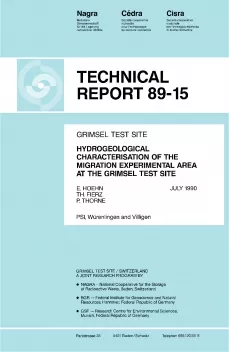
Technical Report NTB 89-15
Grimsel Test SiteHydrogeological characterisation of the migration experimental area at the Grimsel Test Site
Tracer migration experiments in a single fracture in granodioritic rock are in progress at the underground Grimsel Test Site (GTS), to test radionuclide transport models and to develop experimental techniques. This report recapitulates the exploration of the site and provides information on the instrumentation of the location chosen for migration experiments.
Preliminary estimations of groundwater flow velocities into the tunnel in four different fracture zones (lamprophyre dikes, and mylonitic zones) led to a selection of a location (at AU96m, GTS metering) considered optimally suited for migration experiments. The hydrogeology of the chosen single (proto)mylonitic fracture was unknown at the scale of about 10 × 10 m and had to be explored with boreholes. Ten boreholes proved that the fracture is an almost planar element in the water-saturated rock mass. Eight boreholes yield sufficient groundwater for the measurement of hydraulic pressure and for groundwater sampling. Most boreholes are equipped with a system of triple packers which isolate the fracture and the borehole mouth. Passive hydraulic tests proved that a hydraulic connection exists between the boreholes and that the transmissivity of the fracture is about 0.6 m2/d. Long-term monitoring revealed a decline of hydraulic pressure of about 0.08 bar/y, which indicates that the hydraulic system has not yet fully reached a steady state.
Plastic sheets mounted on the wall of the tunnel at its intersection with the fracture allow the measurement of the discharge of groundwater, which is in the order of 0.5 L/min at the migration location. From the observation of breakthrough phenomena during drilling of boreholes and the miscible displacement of groundwaters of a slightly different composition during injection-extraction experiments, a flow velocity at the migration location was estimated to be in the order of a few meters per hour. The groundwater does not contain tritium in detectable amounts and, therefore, the reservoir volume of groundwater, which discharges to the tunnel, must be high (i.e. more than 200 m3). The fracture of interest is probably hydraulically connected to a major shear zone in the area.
